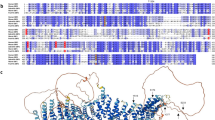Abstract
The Arf family of GTP-binding proteins is highly conserved and widely expressed in eukaryotic cells. Arfs can be divided into three classes based on amino-acid sequence. Class I Arfs include mammalian Arfs 1-3, Class II includes Arfs 4, and 5, and Class III Arfs have only one member-Arf6 (1). All Arf proteins have been shown to share a number of biochemical properties in vitro including: serving as cofactors in the ADP-ribosylation of Gs-alpha subunits induced by cholera toxin, activating phospholipase D (PLD), and activating phosphatidylinositol 4-phosphate 5-kinase (2). However, since each Arf is broadly expressed, they must serve specific functions in cells. Our goal has been to define these functions in cells. Of these proteins, Arf1 is the most widely studied in cells and in biochemical assays. It is involved in the regulation of membrane traffic between the endoplasmic reticulum (ER) and Golgi complex and in the maintenance of the organization of the Golgi complex (3). Arf1 serves this dual function through the modification of Golgi-membrane lipid composition and the assembly of cytosolic coat-protein complexes onto Golgi membranes.
Access this chapter
Tax calculation will be finalised at checkout
Purchases are for personal use only
Similar content being viewed by others
References
Moss, J. and Vaughan, M. (1998) Molecules in the ARF orbit. J. Biol. Chem. 273, 21,431–21,434.
Donaldson, J. G. and Jackson, C. L. (2000) Regulators and effectors of the ARF GTPases. Curr. Opin. Cell Biol. 12, 475–482.
Lippincott-Schwartz, J., Cole, N. B., and Donaldson, J. G. (1998) Building a secretory apparatus: role of ARF1/COPI in Golgi biogenesis and maintenance. Histochem. Cell Biol. 109, 449–462.
Peters, P. J., Hsu, V. W., Ooi, C. E., Finazzi, D., Teal, S. B., Oorschot, V., et al. (1995) Overexpression of wild-type and mutant ARF1 and ARF6: distinct perturbations of nonoverlapping membrane compartments. J. Cell Biol. 128, 1003–1017.
van Donselaar, E., Hsu, V. W., Yang, C., Stahl, P. D., and Peters, P. J. (1998) ARF6 targets recycling vesicles to the plasma membrane: insights from an ultrstructural investigation. J. Cell Biol. 140, 603–616.
D’Souza-Schorey, C., Li, G., Colombo, M. I., and Stahl, P. D. (1995) A regulatory role for ARF6 in receptor-mediated endocytosis. Science 267, 1175–1178.
Radhakrishna, H. and Donaldson, J. G. (1997) ADP-ribosylation factor 6 regulates a novel plasma membrane recycling pathway. J. Cell Biol. 139, 49–61.
Radhakrishna, H., Klausner, R. D., and Donaldson, J. G. (1996) Aluminum fluoride stimulates surface protrusions in cells overexpressing the ARF6 GTPase. J. Cell Biol. 134, 935–947.
Radhakrishna, H., Al-Awar, O., Khachikian, Z., and Donaldson, J.G. (1999) ARF6 requirement for Rac ruffling suggests a role for membrane trafficking in cortical actin rearrangements. J. Cell Sci. 112, 855–866.
Jackson, T. R., Brown, F. D., Nie, Z., Miura, K., Foroni, L., Sun, J., et al. (2000) ACAPs are Arf6 GTPase-activating proteins that function in the cell periphery. J. Cell Biol. 151, 627–638.
Wolf, J., Dagher, M.C., Fuschs, A., Geiszt, M., and Ligeti, E. (1996) In vitro activation of the NADPH oxidase by fluoride-possible involvement of a factor activating GTP hydrolysis on Rac. Eur. J. Biochem. 239, 369–375.
Song, J., Khachikian, Z., Radhakrishna, H., and Donaldson, J. G. (1998) Localization of endogenous ARF6 to sites of cortical actin rearrangement and involvement of ARF6 in cell spreading. J. Cell Sci. 111, 2257–2267.
Zhang, Q., Cox, D., Tseng, C., Donaldson, J. G., and Greenberg, S. (1998) A requirement for ARF6 in Fcg receptor-mediated phagocytosis in macrophages. J. Biol. Chem. 273, 19,977–19,981.
Frank, S. R., Hatfield, J. C., and Casanova, J. E. (1998) Remodeling of the actin cytoskeleton is coordinately regulated by protein kinase C and the ADP-ribosylation factor nucleotide exchange factor ARNO. Mol. Biol. Cell 9, 3133–3146.
Franco, M., Peters, P. J., Boretto, J., van Donselaar, E., Neri, A., D’Souza-Schorey, C., et al. (1999) EFA6, a sec7 domain-containing exchange factor for ARF6, coordinates membrane recycling and actin cytoskeleton organization. EMBO J. 18, 1480–1491.
Bonifacino, J. S., Suzuki, C. K., Lippincott-Schwartz, J., Weissman, A. M., and Klausner, R. D. (1989) Pre-Golgi degradation of newly synthesized T cell antigen receptor chains: intrinsic sensitivity and the role of subunit assembly. J. Cell Biol. 10, 73–83.
Al-Awar, O., Radhakrishna, H., Powell, N. N., and Donaldson, J. G. (2000) Separation of membrane trafficking and actin remodeling functions of ARF6 with an effector domain mutant. Mol. Cell. Biol. 20, 5998–6007.
Vasudevan, C., Han, W., Tan, Y., Nie, Y. Li, D., Shome, K., et al. (1998) The distribution and translocation of the G protein ADP-ribosylation factor 1 in live cells is determined by its GTPase activity. J. Cell Sci. 111, 1277–1285.
D’Souza-Schorey, C., Boshans, R. L., McDonough, M., Stahl, P. D., and Van Aelst, L. (1997) A role for POR1, a Rac 1-interacting protein, in ARF6-mediated cytoskeletal rearrangements. EMBO J. 16, 5445–5454.
Author information
Authors and Affiliations
Editor information
Editors and Affiliations
Rights and permissions
Copyright information
© 2002 Humana Press Inc.
About this protocol
Cite this protocol
Donaldson, J.G. (2002). Arf6 and its Role in Cytoskeletal Modulation. In: Manser, E., Leung, T. (eds) GTPase Protocols. Methods in Molecular Biology™, vol 189. Springer, Totowa, NJ. https://doi.org/10.1385/1-59259-281-3:191
Download citation
DOI: https://doi.org/10.1385/1-59259-281-3:191
Publisher Name: Springer, Totowa, NJ
Print ISBN: 978-0-89603-934-6
Online ISBN: 978-1-59259-281-4
eBook Packages: Springer Protocols




